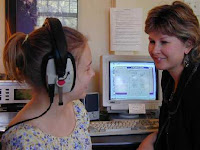Auditory Integration Training: Help for Sensory Problems
 Auditory Integration Training (AIT) was used in the early 1990s as a treatment for autism. It has also been promoted as a treatment for ADHD, depression, and a wide variety of other disorders. It typically involves 20 half-hour sessions over 10 days listening to specially filtered and modulated music. The American Academy of Pediatrics and three other professional organizations consider AIT to be an experimental procedure.
Auditory Integration Training (AIT) was used in the early 1990s as a treatment for autism. It has also been promoted as a treatment for ADHD, depression, and a wide variety of other disorders. It typically involves 20 half-hour sessions over 10 days listening to specially filtered and modulated music. The American Academy of Pediatrics and three other professional organizations consider AIT to be an experimental procedure.
AIT aims to address the sensory problems such as hearing distortions and hyperacusis (i.e., oversensitive hearing), which are said to cause discomfort and confusion in children suffering from learning disabilities, including autism spectrum disorders. These hypersensitivities are believed to interfere with a youngster’s attention, comprehension, and ability to learn.
The training typically involves the youngster attending two 30-minute sessions per day, separated by a minimum of three hours, for ten consecutive working days. The youngster listens via headphones to a program of specially filtered and modulated music with wide frequency range. The program is modified for each youngster with certain frequencies of sound filtered using an electronic device, which randomly switches between low- and high-pass filtering for random durations between 1/4 and 2 seconds. The filtering device also varies the sound's intensity, creating a modulated effect. The volume is set as loud as possible without causing discomfort. If the listener has shown unusual sensitivities to certain frequencies, these may be filtered out additionally.
Although no AIT device has been approved for marketing as a medical device by the FDA, devices used only to aid education are not subject to FDA regulation.
Most AIT practitioners are speech-language pathologists or audiologists and occupational therapist. Other practitioners include psychologists, physicians, social workers, and teachers.
Parents who are seeking interventions for their Aspergers (high functioning autistic) youngster should explore the many options currently available and evaluate each one. Factors to evaluate include:
- cost and accessibility
- the benefit versus the risk
- the effectiveness of the intervention
- the timing of the program relative to other interventions that are being done
- whether it is appropriate for their particular youngster
There are some immediately recognized advantages to Auditory Integration Training:
- it can be provided as young as 3 years of age
- it only requires 10 days, with two 30 minute listening sessions each day
- the main pre-requisite skill is that the listener must accept the head-phones
Many Aspergers kids receiving special education services often have an undiagnosed problem with the way they hear and process information, thus learning and behavior may be affected by problems (e.g., hearing distortions, hypersensitive hearing, lack of coordination, processing delays, etc.),which interfere with efficient processing of sound signals.
AIT stimulates the auditory system with unique sounds that stimulate the auditory system to reduce or eliminate the problems within this system. AIT is a method of retraining the way the sounds are processed. When the Aspergers child can process sounds properly, he/she can maintain a state of alert readiness, concentration, and effective comprehension.
The auditory system is responsible for many jobs other than hearing. For example, the auditory system:
- assists in the control of eye movements
- assists in the control of the hand and fingers when writing
- contains the control center for all sensory processing
- controls balance
- controls motor planning and coordination
- enables people to use language
- help us sing on key
Thus, it makes sense that when the auditory system is not functioning effectively, many diverse problems may appear, including:
- delays in speech and language development
- difficulty with reading skills
- difficulty with vision skills
- poor balance and motor coordination skills
- poor concentration
- poor fine motor skills
- problems with sensory processing
When the auditory system is retrained, the benefits may extend well beyond just the ability to listen better. Moms and dads often report improvement in their Aspergers youngster’s ability to ride a bike, catch a ball, pronounce words, and modulate speech volume.
Other reported benefits include the following:
- children are able to attend and concentrate on the important things
- hearing sensitivity is often reduced (as a result, the child no longer needs to cover his ears or avoid crowds and noisy events)
- many children are calmer
- many children begin to color, draw and write with more skill
- many moms and dads and professionals report that the youngster’s educational progress accelerates
- many show a higher level of self-confidence
- most children begin to show increased interest in socialization
- occupational, speech/language and physical therapists comment that IEP goals are mastered much more quickly
- some Autistic kids may begin to speak for the first time
- some demonstrate less anxiety and irritability
- some quickly learn to tie their shoes or button clothes
- the need to constantly regulate sensory experiences decreases (e.g., covering the ears, wearing noise-protection headsets)
- those who have been speaking may expand to much more complex use of language
The Aspergers Comprehensive Handbook


